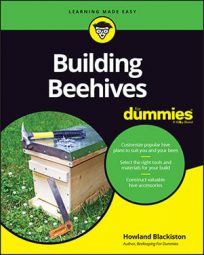The Warré hive is simple, cost-effective, and has an efficient design. It has been gaining renewed popularity among DIY beekeepers and those seeking more natural approaches to beekeeping.
![[Credit: Illustration by Felix Freudzon, Freudzon Design]](https://www.dummies.com/wp-content/uploads/356616.image0.jpg)
Vital stats for the Warré hive
Have a look at some statistics and tips for building a Warré hive:
Overall size: 18 inches x 19-3/4 inches x 47-3/16 inches.
Capacity: The tall, vertical design, made up mostly of four hive boxes, provides ample room for the colony to naturally grow throughout the season.
Type of frame: This design uses a top-bar style of frame. It has no side bars or bottom bar and no full sheets of beeswax foundation to deal with (or the costs associated with these elements). The bees build their comb naturally and without restriction onto each of the top bars in the hive (32 frames in all).
Universality: This characteristic is less important with this design than with others. All the gadgets and add-ons that you might use with a conventional Langstroth hive (feeders, queen excluders, foundation, and honey-extracting equipment) are irrelevant to the Warré.
Its design is virtually all-inclusive and requires no extras. However, if you need a new roof and don’t want to make another one, an increasing number of beekeeping supply stores offer prebuilt Warré components. Just make sure the dimensions of the commercially made hives jibe with your dimensions (Warré measurements are less standardized than those of the more-popular Langstroth hive).
Degree of difficulty: As beehives go, this is likely one of the easiest to build. It has no complex joinery, and you don’t have to build complicated frames or insert foundation. All in all, this design has fewer components to deal with than a Langstroth or British National hive. It’s a winner!
Cost: Using scrap wood (if you can find some) would keep material costs of this design minimal, but even if you purchase the recommended knotty pine, hardware, and fasteners, you can likely build this Warré hive (top bar frames and all) for less than $75.
Materials list for the Warré hive
The following table lists what you’ll use to build your Warré hive and the top bar frames used with it. In most cases, you can make substitutions as needed or desired.
| Lumber | Hardware | Fasteners |
|---|---|---|
| 5, 8' lengths of 1" x 10" knotty pine lumber | 1/2, pound beeswax (to melt and brush on the frames’ starter strips) | 10, #6 x 5/8" wood screws, #2 Phillips drive, flat-head |
| 1, 8' length of 2" x 3" knotty pine | Burlap (hessian) cloth, available at hardware and garden supply stores; you only need a small piece (135/16" x 135/16"). You may need to purchase a roll of burlap and cut to this dimension. | 70, #6 x 1-3/8" deck screws, galvanized, #2 Phillips drive, flat-head with coarse thread and sharp point |
| 1, 2' x 4' sheet of 3/8" thick exterior plywood | Enough insulation material to fill the quilt box — you can use dry leaves, straw, wood chips, pine needles, or coarse sawdust | 100, 6d x 2" galvanized nails |
| 1, 12" x 36" x 3/32" balsa wood sheet | Optional: weatherproof wood glue | 20, 3/8" staples for use in a heavy-duty staple gun |
| Optional: a quart of latex or oil exterior paint (white or any light color), exterior polyurethane, or marine varnish | ||
Here are a couple of notes about the materials for your Warré hive:
Because of its simple butt-joinery, knotty pine is perfectly okay for this hive, and it’s about the least expensive board lumber out there. But pine isn’t the most durable wood, so it benefits from a protective coating of paint, varnish, or polyurethane. Alternatively, consider keeping your hive as all-natural as possible by using cedar or cypress.
Although these woods are more expensive than knotty pine, they stand up well to weather without paint or protective chemicals.
You can purchase 3/32 inch thick sheets of balsa wood online or from a hobby store. Use a utility knife to cut the balsa sheets into the 10 inch x 3/4 inch starter strips.
There are a few more fasteners than you’ll use because you’ll probably lose or bend a few along the way. It’s better to have a few extras on hand and save yourself an extra trip to the hardware store.

